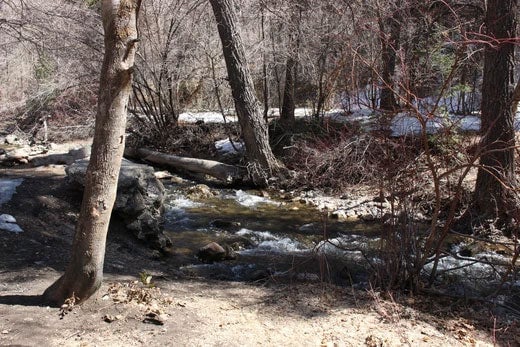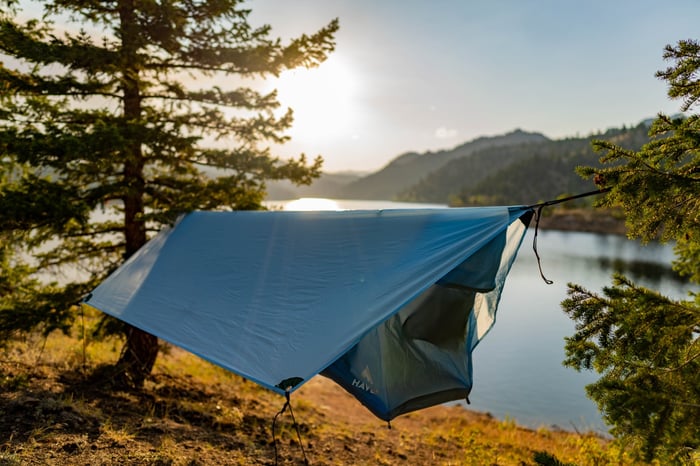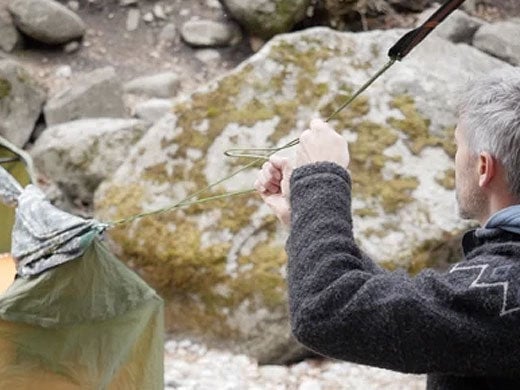A little rain never hurt anyone during the day, but to me, the difference between a fun campout and a dreary, miserable campout is being able to return to a nice dry, clean tent at the end of the day.
Growing up in Washington state wet weather was just part of camping. If you waited for perfect warm, sunny weather you’d basically never go.
Whether you’re looking to do some Spring camping or you’re in a part of the world with a lot of rain follow these tips to help keep you and your gear dry.
-
Analyze the ground
Look at the place where you want to pitch your tent. Is the ground already wet? Are their leaves or pine needles absorbing moisture? Is the ground lower than the surrounding area? If it starts to rain where will the water naturally flow?

In this picture the ground has two different channels. One runs to the right and down into the river and the other runs up through the trees and then to the right and back to the river. Additionally, if you look at the area in the circle there is a slight depression that is capturing water, making for a poor place to set up. The area to the left in the picture is the area's high ground and you can tell the ground itself is drier.
Do your best to pitch your tent on higher ground or in an area that absorbs less moisture. If the ground is highly saturated once you put your tent down the contact with the ground can cause the moisture to come up causing a dew-like effect especially on the rim of the tent’s floor tarp. If it’s wet enough this could end up flooding your tent with an inch or so of water around the base. Trust me it’s not fun.
I set up the tent on the left side ground pictured before. Here it sits in between two spots water naturally flows away from and avoids some of the worst of the mud.
-
Bring a Tarp or Two

Putting a tarp down that you then pitch your tent on adds another barrier to prevent water from seeping up from below. By adding another layer of protection you can keep your tent drier longer. Just be sure to fold any part of the tarp that sticks out back underneath the tent. If you don’t the exposed tarp could catch rainwater and pull it underneath the tent causing the water to seep in and get you and your gear wet.
If it’s raining very hard a tent’s rainfly can be overwhelmed and you can start to have water drip inside. If you pitch a tarp like an extra rain fly over your tent not only can you stay dry, but if the tarp is large enough you can create a kind of porch for your tent. You can take off your shoes and remove wet gear before proceeding inside the tent itself. To pitch the tarp over the tent consider tying a rope between two trees above your tent and staking down the tarp with straps/guy lines through the tarp’s eyelets. Or you can place the tarp directly over the tent, again just be sure to stake it down. Either way also be sure to stake the tarp so that the center has a slight angle. That way the water can slide down away from your tent and gear, otherwise water could pool on top of the tarp and you don’t want to be under that when the water pulls the tarp down!
If it’s raining as you are trying to set up your tent you can consider setting up the tarp first to prevent water from getting inside the tent before you are able to set up the rainfly.
-
Bring a trowel
Early on in my scouting experience, I learned that you don’t always get to pick the best campsite. Sometimes you have to camp in a small gully, or sometimes you just know a big storm is going to blow through. In those times it’s nice to have a small gardening trowel. You can dig a small trench around your tent. The trench can catch excess water and guide it away from your tent, building your own small high ground. Try to dig the trench as close to the edge of your tent as possible so that as rain starts to come down off your rainfly it flows directly into the trench and away from your tent site.
When digging the trench keep a few things in mind:
Where is the local high ground?
Where is the most water likely to wash in from if it rains heavily?
Where is the low ground or where will the water flow after it comes through your camp?
Find the spot where the water will first flow in relation to your tent and start your trench from there. Dig the trench progressively deeper until you get to the part where the water will flow out, by creating a slight difference in elevation within your trench it will help the water flow around your tent and out past your campsite.
If all these extra steps sound like too much work don’t worry! You can bypass most of these issues with a Haven Tent! By slinging up off the ground you eliminate your biggest point of contact with moisture.

With the Haven system, it’s easy to set up the rainfly before hanging the tent body itself to ensure that your Haven stays dry even when you need to pitch it in a rainstorm. With the included guidelines you can create a nice little "front porch" for taking of muddy shoes.

And in those especially stormy moments, the Haven Tent’s design and included stakes and guy-lines make it easy to properly sling a tarp on top or expand your “front porch”.

Don’t let the rain keep you from enjoying the outdoors. Find your Haven today!




